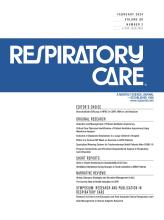This article requires a subscription to view the full text. If you have a subscription you may use the login form below to view the article. Access to this article can also be purchased.
Abstract
BACKGROUND: Jet nebulizers are commonly used for bronchodilator therapy in COPD. High-flow nasal cannula with vibrating mesh nebulizer (HFNC-VMN) is a recently developed system; however, few studies have compared the efficacy of bronchodilator administration via HFNC-VMN to jet nebulizer in stable COPD. This study aimed to compare the effect of salbutamol administered via HFNC-VMN versus jet nebulizer on airway and lung function in subjects with stable COPD.
METHODS: This randomized non-inferiority crossover physiologic study enrolled subjects with stable COPD. Salbutamol was nebulized via HFNC-VMN or jet nebulizer in random order with a 4-h washout period between crossover sequences. Spirometry, lung volume, and impulse oscillometry were performed at baseline and after each intervention. The primary outcome was change in FEV1 from baseline. Secondary outcomes included changes in other respiratory-related parameters and nebulization time compared between the 2 devices.
RESULTS: Seventeen subjects were enrolled. HFNC-VMN and jet nebulizer both significantly improved FEV1 from baseline (P = .005 and P = .002, respectively). The difference between respiratory resistance at 5 Hz and 20 Hz significantly decreased after HFNC-VMN compared to baseline (P = .02), while no significant change was observed after jet nebulizer (P = .056). Area of reactance and resonant frequency of reactance were both significantly decreased (P = .035 and P = .03, respectively), and respiratory reactance at 5 Hz significantly increased (P = .02) in the HFNC-VMN group compared to baseline indicating improved lung mechanics, with no significant changes with the jet nebulizer. HFNC-VMN had a shorter nebulization time (6 [5–9] min vs 20 [16–22] min, respectively, P < .001).
CONCLUSIONS: Bronchodilator therapy via HFNC-VMN was not inferior to jet nebulizer for subjects with stable COPD and can significantly improve airway oscillometry mechanics and decrease nebulization time compared to jet nebulizer.
Footnotes
- Correspondence: Nuttapol Rittayamai MD, Division of Respiratory Diseases and Tuberculosis, Department of Medicine, Faculty of Medicine Siriraj Hospital, Mahidol University, 2 Wanglang Road, Bangkoknoi, Bangkok 10700, Thailand. E-mail: nuttapol.rit{at}mahidol.ac.th
Dr Brochard discloses relationships with Medtronic Covidien, Fisher & Paykel, Philips, Sentec, Air Liquide Medical Systems, GE Healthcare, and St. Michael's Hospital. Dr Chow discloses relationships with Thorasys Thoracic Medical Systems and AstraZeneca Canada. The remaining authors have disclosed no conflicts of interest.
This study was funded by a grant from the Faculty of Medicine Siriraj Hospital, Mahidol University, Bangkok, Thailand (grant number [IO] R016431063). Devices, including the vibrating mesh nebulizer and the high-flow nebulization connector, were generously provided by Fisher & Paykel Healthcare and the Pisces Medical Company Limited. The sponsor had no role in the design of the study, the collection and analysis of the data, or the preparation of the manuscript.
Supplementary material related to this paper is available at http://www.rcjournal.com.
See the Related Editorial on Page 269
- Copyright © 2024 by Daedalus Enterprises
Pay Per Article - You may access this article (from the computer you are currently using) for 1 day for US$30.00
Regain Access - You can regain access to a recent Pay per Article purchase if your access period has not yet expired.







